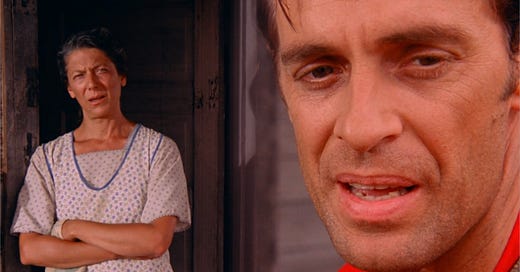Split diopter shots are often about scenes where we can choose which performance to watch (like this scene from Fargo or this from Rake), what the audience sees that characters don’t (like three examples below), or wider shots with two disparate or far-apart things (such as a pursuer bearing down while the prey is up close in Pulp Fiction).
As a rule of thumb, the split diopter blur-line is often hidden by a wall or doorway, a distinct change in colour, a lamppost, etc.; any straight-lined item or ‘break’ in the plane will help hide it.
Usually filmmakers avoid moving the camera, or having character move ’through’ the blur (though this scene from Poker Face makes a comment about character status by ‘crossing’ the blur).
The Ballad of the Sad Café uses a split diopter several of these ways.
Two Hander
This is the most standard of the film’s split uses - though Marvin (Keith Carradine) is looking away from the townsperson he’s talking to, we can see every emotion across his face, as well as the annoyance and suspicion on hers, for the entire conversation.
It’s the most simple, but the composition is still well-considered; the background character’s eyes guide us to the foreground characters, whose eyes in turn lead us into the next cut.
Group Scene
This scene starts with a ‘normal’ wide shot:
before cutting into a split diopter shot to give us a gorgeous, unusual composition with several planes to look at:
As the characters talk they’re all in regular singles, quite close up:




Then in a bold move, Stumpy swigs his moonshine, bringing his hand and the sweating mason glass jar right into the blurry dividing line:
It seems as though this was either a choice to not let a technical aspect stand in the way of the actors acting / reacting, or even a choice to draw attention to the split. Either way, it detracts nothing from the scene.
Thought Process
This shot lets us see Miss Amelia (Vanessa Redgrave) in the foreground thinking about what's behind her, where we clearly see four pairs of staring eyes:
The last shot is similar to both #1 and #3 above - a twohander, giving us character thought process - but even more stylised.
We see Marvin up close while the 'focus' of his thoughts Miss Amelia approaches from afar, still clear as day because of the split focus
Though the line is mostly over the edge of the doorframe, it also catches Marvin’s ear.
The doorway and tulle almost frame her as a thought bubble, a really wonderful effect.
So How Should We Use A Split?
Well, how shouldn’t we?!
Don't be afraid of technical formalities or ‘rules’ - consider what you’re trying to say with the shot or scene, then fuck around and find out.








